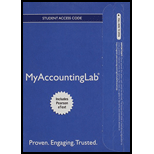
Concept explainers
(1)
Accounts receivable refers to the amounts to be received within a short period from customers upon the sale of goods and services on account. In other words, accounts receivable are amounts customers owe to the business. Accounts receivable is an asset of a business.
Bad debt expense:
Bad debt expense is an expense account. The amounts of loss incurred from extending credit to the customers are recorded as bad debt expense. In other words, the estimated uncollectible accounts receivable are known as bad debt expense.
Allowance method:
It is a method for accounting bad debt expense, where uncollectible accounts receivables are estimated, and recorded at the end of particular period. Under this method,
Write-off:
Write-off refers to deduction of a certain amount from accounts receivable, when it becomes uncollectible.
To journalize: The given transactions using allowance method.
(2)
the ending balance of accounts receivable, allowance for bad debts, and bad debt expense using T-account.
(3)
To show: The way of reporting accounts receivable on the
Want to see the full answer?
Check out a sample textbook solution
Chapter 8 Solutions
MyLab Accounting with Pearson eText -- Access Card -- for Horngren's Financial & Managerial Accounting, The Financial Chapters (My Accounting Lab)
- Really Fast Delivery Services has the collected the following information about operating expenditures for its delivery truck fleet for the past five years: Year Miles Operating Costs 2009 110,000 $390,000 2010 140,000 $420,000 2011 100,000 $360,000 2012 130,000 $410,000 2013 170,000 $450,000 What is the best estimate of total operating expenses for 2014 using the high- low method based on total expected miles of 120,000?arrow_forwardPlease give me true answer this financial accounting questionarrow_forwardWhat is the depreciation for year 2 ?arrow_forward
- Regent Corp uses the straight-line method. Assets purchased between the 1st and 15th of the month are depreciated for the entire month; assets purchased after the 15th of the month are treated as though they were acquired the following month. On July 8, 20X3, Regent Corp purchased equipment for $30,000 that it expects to last for 12 years; Regent Corp expects the equipment to have a residual value of $2,000. What is the 20X3 depreciation expense for the equipment?arrow_forwardytttttttttttttttttttarrow_forwardWhat is the amount of overapplied or underapllied overhead?arrow_forward
 Financial Accounting: The Impact on Decision Make...AccountingISBN:9781305654174Author:Gary A. Porter, Curtis L. NortonPublisher:Cengage Learning
Financial Accounting: The Impact on Decision Make...AccountingISBN:9781305654174Author:Gary A. Porter, Curtis L. NortonPublisher:Cengage Learning College Accounting (Book Only): A Career ApproachAccountingISBN:9781337280570Author:Scott, Cathy J.Publisher:South-Western College Pub
College Accounting (Book Only): A Career ApproachAccountingISBN:9781337280570Author:Scott, Cathy J.Publisher:South-Western College Pub College Accounting (Book Only): A Career ApproachAccountingISBN:9781305084087Author:Cathy J. ScottPublisher:Cengage Learning
College Accounting (Book Only): A Career ApproachAccountingISBN:9781305084087Author:Cathy J. ScottPublisher:Cengage Learning Cornerstones of Financial AccountingAccountingISBN:9781337690881Author:Jay Rich, Jeff JonesPublisher:Cengage LearningPrinciples of Accounting Volume 1AccountingISBN:9781947172685Author:OpenStaxPublisher:OpenStax College
Cornerstones of Financial AccountingAccountingISBN:9781337690881Author:Jay Rich, Jeff JonesPublisher:Cengage LearningPrinciples of Accounting Volume 1AccountingISBN:9781947172685Author:OpenStaxPublisher:OpenStax College





